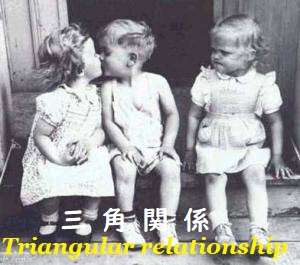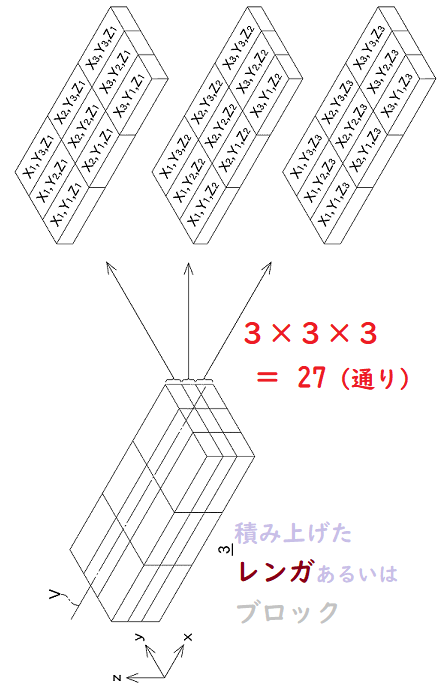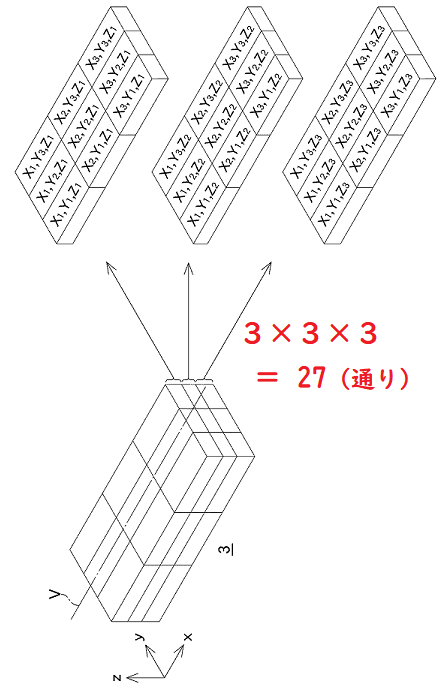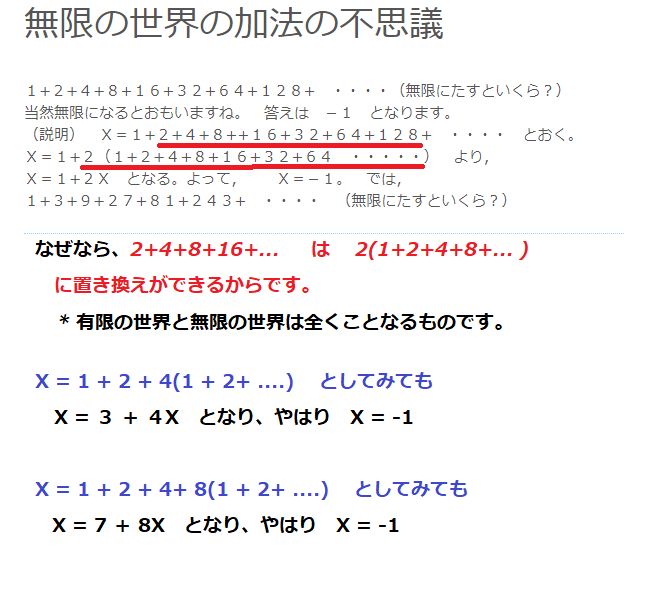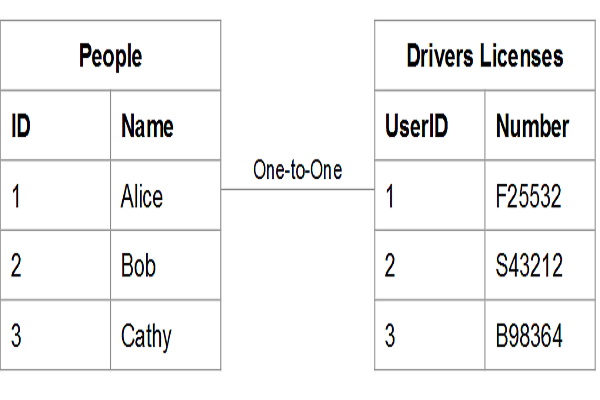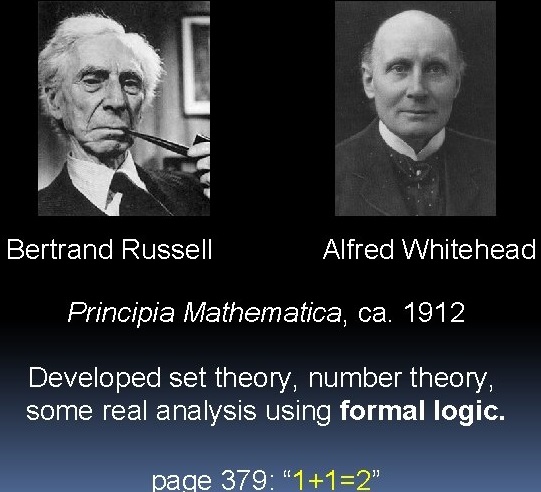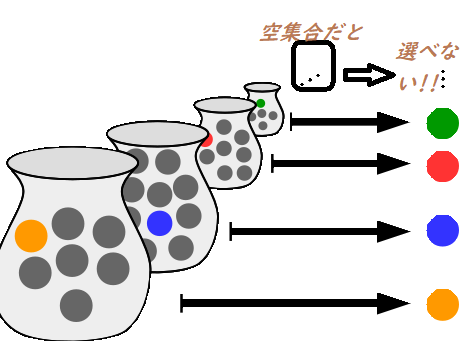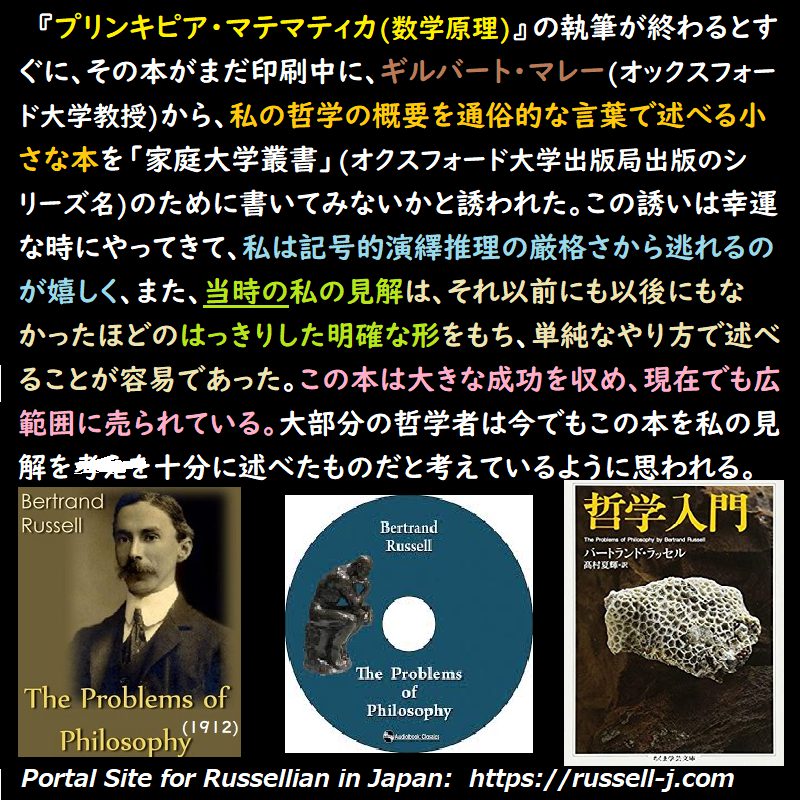
『プリンキピア・マテマティカ(数学原理)』の執筆が終わるとすぐに、その本がまだ印刷中に、ギルバート・マレー(George Gilbert A. Murray, 1866-1957: 英国の古典学者で、オックスフォード大学及びハーバード大学の教授を務めた。)から、私の哲学の概要を通俗的な言葉(in popular terms 通俗的な用語を使って)で述べる(setting out)小著を「家庭大学叢書」(The Home University library オクスフォード大学出版局のシリーズもの)のために書いてみないかと誘われた。この誘いは幸運な時にやってきて、私は記号的演繹推理の厳格さから逃れるのが嬉しく、また、当時の私の見解は、それ以前にも以後にもなかったほどのはっきりした(クリアカットの)明確な形をもち、単純な(simple 複雑でない)やり方で述べることが容易であった。この本は大きな成功を収め、現在でも広範囲に売られている(読まれている)。大部分の哲学者(たち)はいまでもこの本を私の見解を考えを十分に述べたものだと考えているように思われる。 読み返してみるとその中で述べた多くのことを今でも私は真だと(正しいと)信じていることに気づく(見い出す)。「知識」は正確な概念でなく、「蓋然的意見」(probable opinion)と分離できるものではない(merge into ~と融合する)ということに、私は今でも同意する(注:科学も含め、疑えないような「確実な知識」というようなものはないということ)。自明性は程度をもつということ、またびとつの一般的命題を、それの真理を示すただびとつの例をも知ることなしに、知りうる。たとえば、「いままで掛け合わされたことのなかったいかなる二つの数(数のペア)も、1,000より大である積(products)をもつ」(という一般命題)を知りうるということに、私は今でも同意する(注:わかりにくいかも知れない。5×3=15ですが、これは「今まで掛け算されたことがなかった」ものではありません。いままで想像されてことのない2つの数字を掛け合わせて1,000以下の例をあげることは不可能です)。しかし、私の見解が(その後)重要な(重大な)変化を受けた他の事柄があります。私はもはや論理の法則が事物の法則であるとは考えない。私は現在では論理の法則を単に言語的なものだと見なしている。(また)私はもはや点や瞬間や粒子(particles)を世界を作る素材(原材料)の一部とは考えない。また、この小さな本で私が帰納(induction)について述べたことは、今ではとても粗雑であると考える。またこの本では、普遍者及び普遍者についての我々の知識について、強い確信をもって述べたが、そういう確信をいまではもはやもっていない。もっとも(though)、私は同じくらいの確信をもって今主張できると思う何か新たな意見(見解)をこの問題(帰納の問題)についてもっているわけではない。
Chapter 9 The External World, n.1 Shortly after the writing of Principia Mathematica was finished, and while the book was still printing, I was invited by Gilbert Murray to write a little book for The Home University Library setting out in popular terms a general outline of my philosophy. This invitation came at a fortunate moment. I was glad to escape from the rigours of symbolic deductive reasoning, and my opinions at that moment had a clear-cut definiteness which they did not have earlier or later and which made them easy to expound in a simple manner. The book had a great success and still sells widely. I think that most philosophers still regard it as an adequate exposition of my opinions. I find, on re-reading, that there is a great deal in it which I still believe in. I still agree that ‘knowledge’ is not a precise conception, but merges into ‘probable opinion’. I still agree that self-evidence has degrees and that it is possible to know a general proposition without knowing any single instance of its truth – e.g. ‘all the pairs of numbers that have never been multiplied together have products greater than 1,000’. But there are other matters on which my views have undergone important changes. I no longer think that the laws of logic are laws of things ; on the contrary, I now regard them as purely linguistic. I no longer think of points, instants, and particles as part of the raw material of the world. What I said about induction in this little book now seems to me very crude. I spoke about universals and our knowledge of them with a confident assurance which I no longer feel, though I have not any new opinions on the subject which I feel prepared to advocate with equal confidence.
Source: My Philosophical Development, chap. 9:1959.
More info.:https://russell-j.com/beginner/BR_MPD_09-010.HTM


